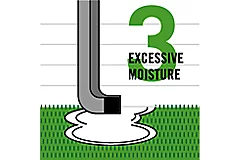Sentricon
Protect Your Investment and Preserve Your Environment with Sentricon
Our Professional will place Sentricon termite treatment stations in the soil around your home. These stations are equipped with new, Always Active™ termite baiting technology that protects your home 24/7/365. As soon as termites discover a Sentricon bait station they begin feeding. The Recruit HD bait is ingested by the workers and then carried back to the colony to be shared. This process continues until the entire colony is eliminated.
Even after the colony has been eliminated, Sentricon continues to guard your property against the invasion of any new termite colonies. You can rest assured that your home and family are being protected around the clock.
Texas Bugs, LLC is a Certified Sentricon® System Specialist
The Sentricon Termite Treatment System is effective at eliminating termites and preventing termite attacks from occurring. Sentricon is the top brand in termite protection. Termites are a threat in any region of the U.S. In approximately 5 million homes every year, termite infestations are discovered. East Texas in particular is a place in which many types of termites thrive, due to the warmth and humidity. To protect what is usually their largest investment, homeowners should remain alert to the potential threat of termites and ensure proper termite treatment prevention. At Texas Bugs, we have highly qualified Subterranean Termite Treatment Baiting System Specialists who receive ongoing training in order to provide effective treatment with Sentricon, for excellent termite treatment protection backed by a guarantee.

6 Signs Termites Might Be Feasting on Your Home
Some home damage — flooding, plumbing issues, a broken heating system — is easy to spot. Other damage, like mold or poor insulation, can be more difficult to detect. Unfortunately, getting to the source of hard-to-identify home damage can take years and cost thousands of dollars if you don’t recognize key warning signs. This is especially true for a significant, but often overlooked, source of property damage: termite infestations.
Termites cost homeowners upward of $5 billion annually, invading more than 5 million homes each year. Thankfully, by learning to recognize the signs of “conducive conditions” — conditions that termites prefer when invading homes to look for food — you can address the problem before it grows.

Wood-to-soil Contact
Is the foundation of your home built with wood? Is there direct contact of soil, mulch and dirt with the wooden siding of your house? Any part of the home where wood and earth meet can act as an entry point for termites, creating easy access into your house. From there, termites can eat their way into your walls, floors, baseboards and attic, causing tens of thousands in structural damage.

Cracks in the Foundation
“I’m not at risk for termites. My home is built on a slab of poured concrete.” Sound familiar? If your home is built on a cement foundation, you might still have termites. Over time, moisture develops cracks in concrete foundations, which termites can use as additional entry points into your home. Termites can crawl through cracks the width of a credit card — no crack is too small for determined colonies, which are constantly foraging for food 24/7, 365 days of the year.

Excessive Moisture
“I’m not at risk for termites. My home is built on a slab of poured concrete.” Sound familiar? If your home is built on a cement foundation, you might still have termites. Over time, moisture develops cracks in concrete foundations, which termites can use as additional entry points into your home. Termites can crawl through cracks the width of a credit card — no crack is too small for determined colonies, which are constantly foraging for food 24/7, 365 days of the year.

New Additions & New Construction
Are you building a new fence, shed, deck or addition to your home? If so, termite prevention should be on your to-do list. Any area of the home that is renovated provides a fresh source of food for nearby termite colonies, which can travel up to 100 yards away — the length of a football field — in search for food! Worse, home renovations often disturb soil, creating pockets of soft, moist earth around any newly constructed wood, which, as we’ve learned, are a one-way ticket for termite home entry.

Trees & Foliage
Yes, the old maple tree in front of your living room window is equal parts beautiful and historic. But did you know it might be a sign of termites? Tree roots can grow 20 feet or more from the base of the trunk, often penetrating the foundation beneath your home and providing termites with a way inside. The closer the tree, the more likely there may be a root path into your home.

No Preventative Treatment
Above all, this is the greatest conducive condition for termites: a lack of preventative treatment to keep colonies at bay. The truth is that, while some homes are more prone to infestation than others, termites live in every state except for Alaska — meaning almost every single home in America is at risk. Chances are high that if termites discover your home, they will find a way inside unless your home is properly protected. You now know that termites can invade your home and cause permanent damage. Fortunately, protecting your property on the front end can save you hundreds, if not thousands, before costly and potentially irreversible damage is done. Armed with this knowledge, now is the time to protect yourself from termites by calling in an expert.
